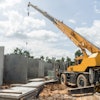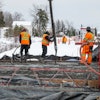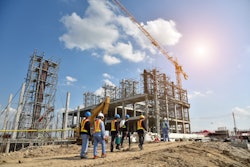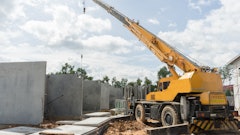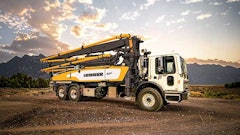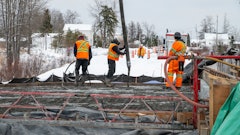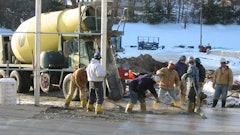
Supply chain disruptions. Evolving sustainable standards. Increased material prices. What seems to be a never-ending deficiency of skilled labor. The compounding problems due to project delays. Not to mention the unpredictable nature of weather, a factor no contractor can truly plan for.
Despite these challenges, concrete contractors are tasked with constructing the foundation of the built world. Concrete Contractor sought out the insight from thought leaders throughout the industry for their point of view.
There’s Supply, But Shouldn’t Demand Be First?
For Mark Reinhart, vice president of sales and marketing at Cemen Tech, one of the top challenges how to deal with the uncertainty of the economy. “For all concrete contractors, as well as dirt and site guys at this point, I think they are struggling with not having a good grasp of what their material costs are going to be,” he says. Read our interview with Reinhart at ForConstructionPros.com/22945158.
Peter Bigwood, general manager at Mecalac North America, calls the threat of tariffs the elephant in the room, noting that any price increase will likely affect the demand for equipment. Likewise, tariffs on any imported steel, aluminum, and cement/concrete are forcing contractors to make up that cost. Read out interview with Bigwood at ForConstructionPros.com/22945692.
Whether it’s due to the tariffs or not remains to be seen at this point, but the effect has already begun. Reinhart has seen contractors hold off on purchasing equipment. They may have a backlog of work, but not having a stronger sense of what to expect next has caused some contractors to hesitate on the next addition to the fleet.
Finding and Keeping Skilled Labor
Nearly every industry leader claimed that the struggle of finding and keeping skilled labor as a challenge. “But that’s not a ‘this year’ problem – that’s been a ‘last five years’ type problem,” says Reinhart. (Although it may have been even longer.)
“Labor shortages continue to be a major challenge,” says Jeff Keeling, vice president of sales and marketing at Brokk Inc. AGC’s 2025 Construction Outlook survey results showed the top three concerns were all tied to labor: not enough workers, rising labor costs, and worker quality. Read our interview with Keeling at ForConstructionPros.com/22945239.
We connected with Don Weaver, president of Weaver-Bailey Contractors and the 2025 Board of Directors Chairman of the American Concrete Pavement Association (ACPA), as well as Edward Wessel, president/COO of Hi-Way Paving Inc. and second vice chair of the ACPA. Both stated that finding skilled labor is always a big challenge, specifically for concrete finishers, equipment operators, mechanics, and saw operators. Read our interview with Weaver and Wessel at ForConstructionPros.com/22945274.
Even still, Dirk Tharpe, territory sales manager at Oldcastle APG, says fewer young people are entering the trades. While there are some areas of the industry that have a compression of work, there is a growing demand for concrete construction, yet the open positions aren’t being filled.
Tharpe believes that one of the factors here is that the upcoming generation often doesn’t have the exposure to the benefits and opportunities of hands-on, skilled work. “As a result, contractors are struggling to find reliable talent to meet growing demand,” he says.
While she agrees that skilled labor, rising material costs, and the volatility of the supply chain are continuing challenges, Marianna Kopsida, PhD, industry manager - IMF & Vertical Construction at Trimble, is adding “data” to the list of challenges for tomorrow’s concrete contractors. Read our interview with Kopsida at ForConstructionPros.com/22945448.
“Concrete contractors have also been struggling with the pervasive challenge of data fragmentation and inconsistent information flow, directly impacting field productivity and increasing costly reworks,” she says.
As the industry continues to integrate more technology into the job, the ability for contractors to have up-to-date data and information will likely be key for tomorrow’s concrete jobs. Consider what it would be like having data on site conditions, design changes, material specs, etc. all at the fingertips of crews.
Kopsida adds, “This disjointed data flow leads to unnecessary time spent validating information, solving avoidable conflicts on the fly, and performing inefficient manual tasks, all of which directly suppress on-site output and lead to significant operational inefficiencies.”
Can This Be Repaired?
The concrete demolition and removal sector shares a similar story. It’s an area within the concrete construction industry that has broken grounds on how implementing modern technology has been aiding contractors to work smarter.
“Modern machines have made incredible strides to become faster and easier to use with more automated functions than ever,” says Keith Armishaw, business development manager – North America at Aquajet. In their case, their hydro-demolition machines use high-pressure water to demo and remove concrete quickly. This keeps a high productivity rate while allowing contractors work safely with reduced physical strain and less exposure to silica dust. Read our interview with Armishaw at ForConstructionPros.com/22945256.
Likewise, Keeling says they hear from contractors regularly who need to find mechanized alternatives to manual labor. “Contractors are looking for solutions like this to maintain their productivity in light of labor shortages and to protect the health and safety of their teams,” he says.
Tools and equipment have been addressing productivity and efficiency forever. That’s the point. The pressures in today’s construction market have only compounded the challenges and caused a “renewed focus” on force multiplication of the workforce, pushing the need of innovation within the industry’s tools and equipment further.
“Contractors are increasingly turning to equipment manufacturers for solutions that deliver greater reliability, lower maintenance requirements, and improved productivity,” says Brand Fredricks, senior manager of product marketing at Milwaukee Tool. Read our interview with Fredricks at ForConstructionPros.com/22946124.
Today’s equipment platforms have been making a measurable impact at the jobsite. Increased safety by using corded equipment when necessary/needed, a quieter tool help with increased communication on-site, optimize the workflow, not to mention the strides in done over the years for ergonomic safety.
There’s also the environmental considerations for both the climate and the contractors well-being. According to Bill Harman, vice president of product management, commercial and general construction at DEWALT, electric equipment platforms have been shown to produce a significant percent less of CO2 emissions during use than gas-powered counterparts. Read our interview with Harman at ForConstructionPros.com/22945207.
Addressing the need for data, their concrete sensor platform with Converge provides contractors compressive strength gain data combined with weather conditions to better predict when their product will reach critical strength. “This optimizes workflows by allowing concrete professionals to begin work sooner as users can directly measure hardening rather than relying on estimation. Users can also more precisely measure the exact amount of cement needed in the mixture, which helps reduce unnecessary cost and carbon emissions,” adds Harman.
One of the ways Weaver and Wessel have been combating the issue by developing the workforce already on staff. They’ve increased training to elevate skills and are hopeful that the effort pays off. On top of additional training, Wessel explains that Hi-Way Paving Inc. has put effort into making the business a place where workers want to stay with PTO programs and a mid-year bonus.
Bigwood has seen similar creative efforts in the industry by offering flexible working conditions, innovative pay schemes, and better training.
Unfortunately, solving the skilled labor issue for concrete contractors isn’t going to be an easy solution. “From being out in the field and on jobsites, my sense is no concrete contractor is immune to labor constraints,” says Harman. He tells us that he has heard of contractors taking fewer contracts while others absorb overtime. Regardless, either method impacts profitability.
Cemen Tech’s Reinhart tells us that of the contractors he’s spoken with, finding drivers has been the number one challenge. He says he’s seen contractors increase benefits to keep good employees and even started considering opening up hiring practices by considering ex-cons/felons.
“We have other customers that will use firefighters because they have their CDL licenses,” he says. “They’re off sometimes three days of the week to hire them to come in and drive.”
In addition to utilizing technology such as robotics and reality capture tools to bridge the labor gap, other contractors, explains Trimble’s Kopsida, have partnered with trade schools.
Twenty Twenty-Six
“The biggest challenge in 2026 will continue to be the shortage of qualified labor,” says Weaver.
However, “the problem goes way beyond the diminishing pool of professional concrete finishers and applicators,” says Tharpe.
“Labor shortages and rising costs will continue to pressure contractors to find smarter, more efficient ways to work,” says Fredricks. “The companies that succeed will be those that embrace innovation, leveraging new technologies to stay ahead of both regulatory and economic challenges.
To put it succinctly, Kopsida anticipates a balancing act between the continued labor shortage and utilizing the right data the right way.
In 2026, I anticipate the biggest challenge for the concrete industry will be the simultaneous pressure to rapidly adopt advanced digital and automated technologies to boost field productivity, while also navigating the complexities of sustainable materials and volatility of costs into daily operations, all within the context of a persistent skilled labor shortage. Balancing the drive for technological efficiency with the imperative for sustainability and workforce development will be the critical hurdle for concrete contractors.

